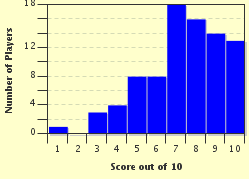Quiz Answer Key and Fun Facts
1. What is the classification of burns into first degree, second degree and so forth based on?
2. During the First World War many soldiers suffered debilitating burns from chemical weapons deployed on the field of battle. What is the common name of the poison first used in mass quantities by the German army in 1917?
3. A patient's Baux score is a number that predicts their probability of surviving after a severe burn. Which of the following is not factored into calculating the Baux score?
4. What is the most common life-threatening complication of burns?
5. Electrical burns tend to cause less damage to the skin than to internal organs such as muscles and nerves.
6. What is the most common cause of radiation burns worldwide?
7. Acid throwing is a particularly vicious form of assault in which perpetrators throw acid or other corrosive liquids at their victims. Which of the following countries had the highest reported rate of attacks at the turn of the 21st century?
8. The term for setting oneself on fire as a radical form of protest is known as self-___.
9. Which of the following is the most appropriate first aid for a minor thermal burn?
10. What novel treatment for burns victims was patented by Australian plastic surgeon Dr Fiona Wood?
Source: Author
lorance79
This quiz was reviewed by FunTrivia editor
rossian before going online.
Any errors found in FunTrivia content are routinely corrected through our feedback system.


